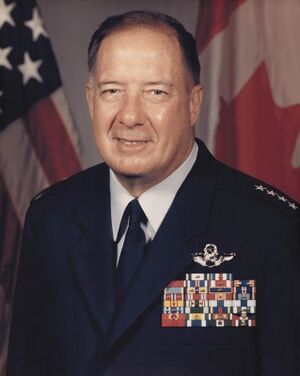Chuck Horner
Not to be confused with Charles Horner (diplomat)
(soldier) | |
|---|---|
 | |
| Born | October 19, 1936 Davenport, Iowa |
| Alma mater | University of Iowa, College of William and Mary, Armed Forces Staff College, Industrial College of the Armed Forces, National War College |
| Member of | Phi Delta Theta |
US Air force general pushing for expansion into space | |
Charles Albert Horner is a retired United States Air Force four-star general. During Operation Desert Shield and Operation Desert Storm, he commanded the American aerial forces, as well as those of the American allies.
He was part of a panel on military use of space, chaired by later defend minister Donald Rumsfeld. The report recommended the Air Force to revisit its initiative to merge air and space operations into a seamless aerospace continuum, setting the stage for creation of a “Space Corps” within the Air Force. The report "found immediate favor in military and intelligence communities". The commission was launched by members of Congress who feel the Air Force is not paying sufficient attention to space, nor allocating enough resources to pursue a suitably strong military space presence. [1]
After retirement he served on the board of directors for the United States Institute of Peace.
Military career
Horner, an Iowa native, entered the United States Air Force through the Reserve Officer Training Corps program. He was commissioned in the Air Force Reserve on June 13, 1958, just before his graduation from the University of Iowa and was awarded pilot wings in November 1959 and was resworn with a regular Air Force commission in 1962.[2]
He has commanded a tactical training wing, a fighter wing, two air divisions and a numbered Air Force. While Commander of 9th Air Force, he also commanded United States Central Command Air Forces, in command of all United States and allied air assets during operations Desert Shield and Desert Storm.[3]
Horner is a command pilot with more than 5,300 flying hours in a variety of fighter aircraft. During the Vietnam War he flew 41 combat missions over North Vietnam in the F-105 during a tour. He later flew more than 70 combat missions as an F-105 Wild Weasel pilot, deliberately drawing anti-aircraft fire to identify and destroy North Vietnamese defenses.[3]
Horner returned to Nellis AFB in August 1967 where, after initial assignment to the Combat Crew Training Wing, he ended up flying as an instructor at the Fighter Weapons School. In March 1968, he joined the new Fighter Weapons Center at Nellis. From 1970 to 1972 he was assigned as a staff officer to Tactical Air Command (TAC) headquarters at Langley AFB, followed by four months of post-graduate work at the College of William and Mary, where he earned his Master of Business Administration. This was followed by a three-year assignment at The Pentagon and subsequent assignment to the National War College at Seymore Johnson AFB.[4]
Horner was Commander in Chief of North American Aerospace Defense Command and the United States Space Command; and Commander of Air Force Space Command, Peterson Air Force Base, Colorado from 1992 to 1994. He was responsible for the aerospace defense of the United States and Canada, and the exploitation and control of space for national purposes through a network of satellites and ground stations around the world.[3]
Education
- 1958 Bachelor of Arts degree, University of Iowa, Iowa City
- 1967 Squadron Officer School, Maxwell AFB, Alabama
- 1972 Master of Business Administration degree, College of William and Mary, Williamsburg, Virginia
- 1972 Armed Forces Staff College, Norfolk, Virginia
- 1974 Industrial College of the Armed Forces, Fort Lesley J. McNair, Washington, D.C.
- 1976 National War College, Fort Lesley J. McNair, Washington, D.C.
References
- ↑ https://www.airforcemag.com/article/0301space/
- ↑ Clancy, Tom; Horner, Chuck (1999), Every Man a Tiger: The Gulf War Air Campaign, Putnam, ISBN 978-0-399-14493-6 p=38
- ↑ a b c https://web.archive.org/web/20090710004200/http://www.af.mil/information/bios/bio.asp?bioID=5859
- ↑ Clancy & Horner 1999, pp. 118–132